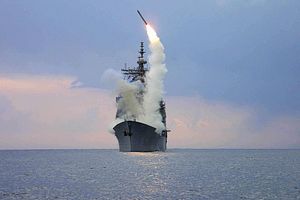Influential Japanese lawmakers are pushing the Japan Self Defense Force (JSDF) to develop long-range preemptive strike capabilities in the face of North Korea’s growing ballistic missile threat, Reuters reported on March 8.
“If bombers attacked us or warships bombarded us, we would fire back. Striking a country lobbing missiles at us is no different,” according to Itsunori Onodera, a former defense minister and member of the ruling Liberal Democratic Party (LPD). “Technology has advanced and the nature of conflict has changed.”
Earlier this week, North Korea launched four ballistic missiles into the Sea of Japan, three of which landed within Japan’s exclusive economic zone (EEZ), according to the Japanese government. The month prior, Japan’s nuclear-armed neighbor test fired a solid-fueled, medium-range ballistic missile.
According to Hiroshi Imazu, chairman of the LDP’s policy council on security, “It is time we acquired the capability. I don’t know whether that would be with ballistic missiles, cruise missiles, or even the F-35 [fighter aircraft] but without a deterrence North Korea will see us as weak.”
The LDP under Japanese Prime Minister Shinzo Abe has been the driving force behind the need for a more proactive approach toward Japanese security and reinterpretation of Japan’s pacifist constitution, which now allows the JSDF “collective self-defense” and limited military support of allies abroad including protecting U.S. warships.
“We have already done the ground work on how we could acquire a strike capability,” a government source told Reuters. Indeed, Japan has considered a number of options, including the U.S.-made Tomahawk long-range subsonic cruise missile. Deployed on Atago-class or Kongo-class of guided missile destroyers (or aboard Soryu-class diesel-electric attack submarines), the sea-based and mobile Tomahawk missile could provide a visible deterrent.
Other possible options include air-launched long-range standoff missiles such as the U.S.-made Joint Air to Surface Standoff Missile (JASSM) or the GBU-31JDAM (Joint Direct Attack Munition) air-to-ground guided bomb dropped off from F-35A Lightning II fifth-generation stealth fighter jets, next to a number of options for shorter-range air-to-ground missiles like the Joint Strike Missile. (Japan has ordered 42 F-35A combat aircraft from the United States.)
Japan could also opt for truck-launched surface-to-surface missiles, a potentially cheaper and faster option for the JSDF.
As I reported elsewhere, Japan has also been stepping up its ballistic missile defense capabilities and recently conducted a flight test of a Standard Missile-3 (SM-3) Block IIA, which can be deployed at land-based Aegis Ashore sites in Japan or aboard Aegis-equipped warships such as the Atagao-class and Kongo-class destroyers. However, according to some sources, Japan’s ballistic missile defense systems, including its shore-based PAC-3 Patriot batteries (slated for an upgrade in 2017), can be overwhelmed by a mere four ballistic missiles.
The debate over the JSDF acquiring more offensive capabilities is nothing new. It has been a frequent topic of discussion among national security experts and the military, accentuated by North Korea’s repeated demonstrations that it is all too willing and capable of striking Japan in the event of a conflict with South Korea and the United States on the Korean Peninsula.
This time, however, the debate could gain faster momentum for two reasons. First, North Korean ballistic missile capabilities have significantly improved over the last two years, according to open source information, which potentially could force the Japanese government to quickly obtain a long-range preemptive strike capability. Second, with the election of Donald Trump to the presidency, Japan can no longer solely rely on the American security umbrella to deter Pyongyang.

































